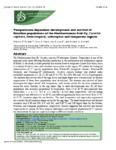Por favor, use este identificador para citar o enlazar este ítem:
http://www.alice.cnptia.embrapa.br/alice/handle/doc/939710Registro completo de metadatos
| Campo DC | Valor | Lengua/Idioma |
|---|---|---|
| dc.contributor.author | RICALDE, P. M. | pt_BR |
| dc.contributor.author | NAVA, D. E. | pt_BR |
| dc.contributor.author | LOECK, E. A. | pt_BR |
| dc.contributor.author | DONATTI, G. M. | pt_BR |
| dc.date.accessioned | 2012-11-28T00:04:23Z | - |
| dc.date.available | 2012-11-28T00:04:23Z | - |
| dc.date.created | 2012-11-14 | pt_BR |
| dc.date.issued | 2012 | pt_BR |
| dc.identifier.citation | Journal of Insect Science, v. 12, n. 29, p. 1-11, 2012. | pt_BR |
| dc.identifier.issn | 1536-2442 | pt_BR |
| dc.identifier.uri | http://www.alice.cnptia.embrapa.br/alice/handle/doc/939710 | pt_BR |
| dc.description | The Mediterranean fruit fly Ceratitis capitata (Wiedemann) (Diptera: Tephritidae) is one of the principal exotic pests affecting Brazilian production in the northeastern and southeastern regions of Brazil. In the south, it is has potential as a serious threat to temperate-climate fruit farms, since it is already found in urban and suburban communities in this region. We studied the biological characteristics of C. capitata populations from Pelotas-RS (temperate climate), Petrolina-PE (tropical), and Campinas-SP (subtropical). Ceratitis capitata biology was studied under controlled temperature (15, 20, 25, 30, and 35 ± 1 °C), 70 ± 10% RH, and 14:10 L:D photoperiod. The duration and survival rate of the egg, larval, and pupal stages were evaluated and the thermal requirements of these three populations were determined. The duration and survival of these developmental stages varied with temperature, with similar values for the three populations, except for some variation in the egg phase. Egg to adult developmental time for all three populations was inversely proportional to temperature; from 15 to 30 °C developmental time varied from 71.2 to 17.1, 70.2 to 17.1, and 68.5 to 16.9 days, respectively. Survival during development was affected at 15 to 30 °C, and differed significantly from survival at 20 to 25 °C. At 35 °C, immature stages did not develop. The basal temperature and degree-day requirement were similar for all immature stages except for the egg stage. The basal temperatures and thermal constants were 9.30 and 350, 8.47 and 341, and 9.60 °C and 328 degree-days for the Pelotas, Petrolina, and Campinas populations, respectively. Results suggested that survival and thermal requirements are similar for these tropical, subtropical, and temperate populations of C. capitata, and demonstrate the species' capacity to adapt to different climate conditions. | pt_BR |
| dc.language.iso | eng | eng |
| dc.rights | openAccess | eng |
| dc.subject | Clima Subtropical | pt_BR |
| dc.subject | Brasil | pt_BR |
| dc.subject | Rio Grande do Sul | pt_BR |
| dc.subject | Pernambuco | pt_BR |
| dc.subject | São Paulo | pt_BR |
| dc.title | Temperature-dependent development and survival of Brazilian populations of the Mediterranean fruit fly, Ceratitis capitata, from tropical, subtropical and temperate regions. | pt_BR |
| dc.type | Artigo de periódico | pt_BR |
| dc.date.updated | 2012-11-28T00:04:23Z | pt_BR |
| dc.subject.thesagro | Mosca das Frutas | pt_BR |
| dc.subject.thesagro | Clima Tropical | pt_BR |
| dc.subject.thesagro | Clima Temperado | pt_BR |
| dc.subject.thesagro | Ceratitis Capitata | pt_BR |
| dc.subject.nalthesaurus | Temperate zones | pt_BR |
| dc.subject.nalthesaurus | Tropics | pt_BR |
| dc.subject.nalthesaurus | Subtropics | pt_BR |
| dc.subject.nalthesaurus | Brazil | pt_BR |
| riaa.ainfo.id | 939710 | pt_BR |
| riaa.ainfo.lastupdate | 2012-11-27 | pt_BR |
| dc.contributor.institution | Marcelo P. Ricalde, Departamento de Fitossanidade, FAEM/UFPel; DORI EDSON NAVA, CPACT; Alci E. Loeck, Departamento de Fitossanidade, FAEM/UFPel; Michele G. Donatti, Departamento de Fitossanidade, FAEM/UFPel. | pt_BR |
| Aparece en las colecciones: | Artigo em periódico indexado (CPACT)  | |
Ficheros en este ítem:
| Fichero | Descripción | Tamaño | Formato | |
|---|---|---|---|---|
| 102.pdf | 1,99 MB | Adobe PDF |  Visualizar/Abrir |









